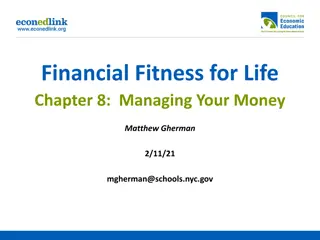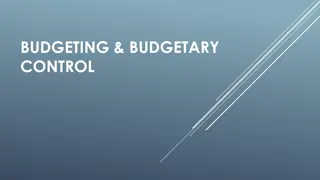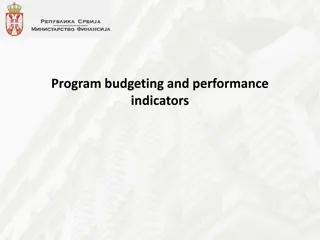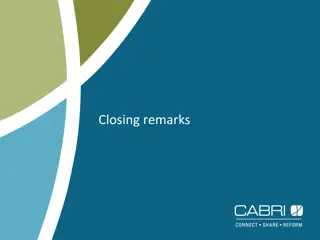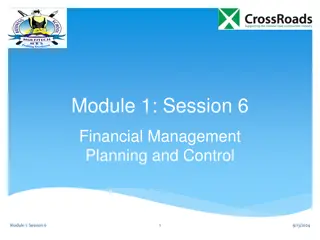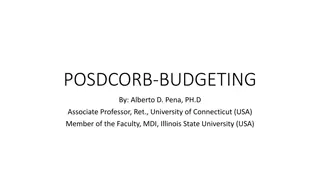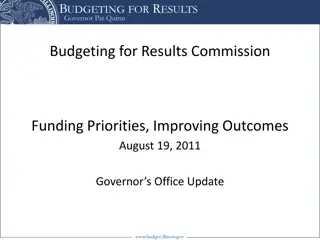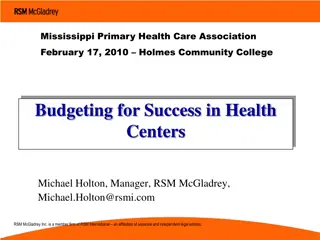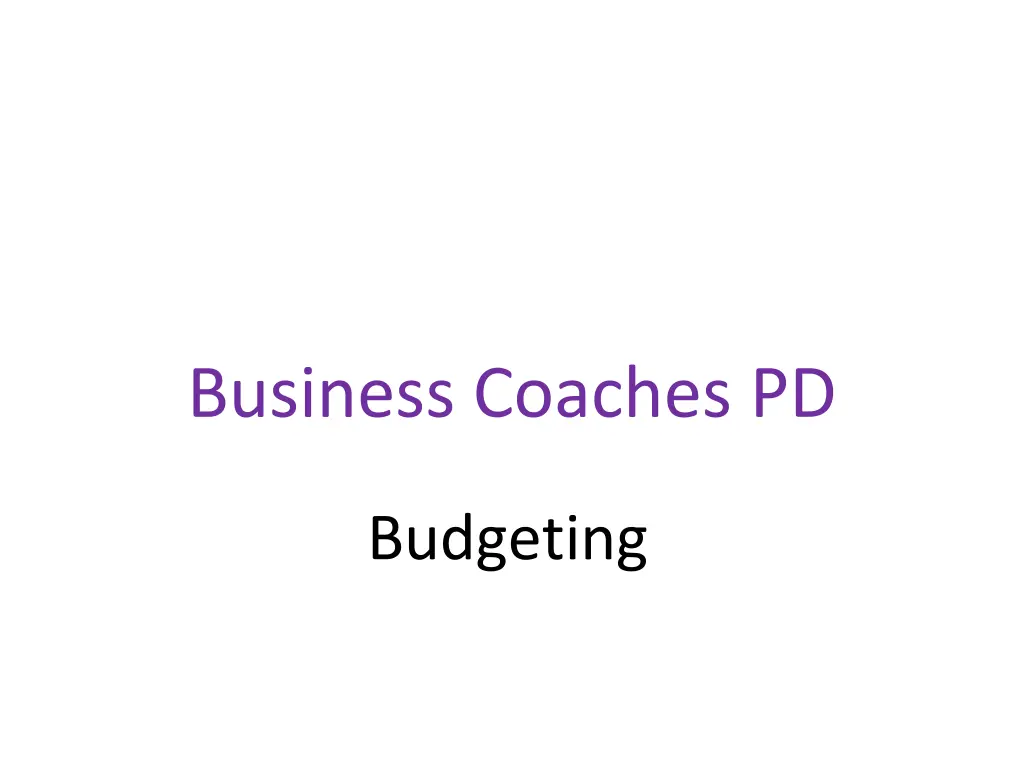
Effective Budgeting Strategies for Business Coaches and Professionals
Discover essential budgeting tools and techniques for business coaches in this comprehensive guide. Learn how to create, analyze, and optimize budgets to support sound decision-making and financial success. Explore budget definitions, types, elements, and comparisons with actuals to improve fiscal health and achieve financial goals effectively.
Download Presentation

Please find below an Image/Link to download the presentation.
The content on the website is provided AS IS for your information and personal use only. It may not be sold, licensed, or shared on other websites without obtaining consent from the author. If you encounter any issues during the download, it is possible that the publisher has removed the file from their server.
You are allowed to download the files provided on this website for personal or commercial use, subject to the condition that they are used lawfully. All files are the property of their respective owners.
The content on the website is provided AS IS for your information and personal use only. It may not be sold, licensed, or shared on other websites without obtaining consent from the author.
E N D
Presentation Transcript
Business Coaches PD Budgeting
Agenda Welcome 2 minutes Content 25 minutes Budget Definition, Purpose, Types & Elements Budgeting Tools Fiscal Data Chart of Accounts Fiscal Team Financial Software Case Study 30 minutes Resources & Next Steps 30 minutes
Budget vs Actuals A budget is a projection or a plan for the amount of money that will be made (revenue) by the child care business and the amount of money that will be spent (expenditures or expenses) to operate the child care business during the fiscal year. Actuals reflect how much money (income) has actually been received and how much money (expenses) has been paid out at a given point in time during a fiscal year. (Talan & Bloom, 2018)
Budgets Support Sound Decision Making Is the budget balanced? Do revenues equal or exceed expenses? Is the business profitable? Is the FCC owner earning a living wage? Saving for retirement? Use budget to generate financial forecasts and plan various scenarios Submit to banks to secure a line of credit or loan needed for cash flow Compare actual to budgeted to assess fiscal health and make necessary course corrections
Budget Types Start-Up One-time costs; recruitment costs; enrollment phase-in Ongoing operational Capital Lost revenue during renovation Program/Classroom Head Start contract, other funding program contract Organization/Center/Business
Budget Elements Expenses Revenues Estimate based on historical data Estimate based on current enrollment and past history Personnel-related expenses should equal approximately 65-75% of all expenses Include vacancy factor/collection ratio Restricted/unrestricted Restricted/unrestricted
Budgeting Tools Fiscal Data Fiscal Team Financial Software
Fiscal Data Standard Chart of Accounts Coding of expenses (actual) Coding of revenue (actual) Data Sources Bank statements Invoices Receipts
Chart of Accounts - Revenue Private Pay Subsidy Program Payments Subsidy Parent Co-Pays Head Start/Early Head Start Child and Adult Care Food Program (CACFP) Grants Fees related to Field Trips Contributions Fundraising Events Other Charges Miscellaneous
Chart of Accounts - Expenses Other Staffing Expenses Payroll Taxes Employee Benefits Professional Fees Staff PD/Training costs
Chart of Accounts FCC Expenses Owner Compensation Owner Retirement Substitute/Employee Wages Payroll Taxes Employee Benefits PD/Training costs
Chart of Accounts - Expenses Contracted Services Legal Financial Services Other Contracted Services
IRS Expense Categories Advertising Insurance Interest Legal & Professional Services Office Expenses Rent Repair & Maintenance Supplies Taxes & Licenses Travel & Entertainment Food Toys HouseholdItems Cleaning Supplies Activity Expenses
Chart of Accounts There is no right/wrong What categories relate program budget forms? How do the categories relate to tax forms? How do the categories relate to the provider s online banking labels? The key is CONSISTENCY
Actual Revenue & Expenses Without a budget, how does a provider know what actual numbers mean? The budget gives CONTEXT is spending within the plan? Are earnings more than expenditures? Is the FCC owner earning a living wage? Why isn t the balance in the business bank account enough information?
Estimating Revenue Revenue from private tuition and all other sources: CACFP Registration fees Other fees Grants Revenue from Tuition Monthly Monthly Tuition x 12 = Tuition Yearly Tuition Revenue Child 1 Child 2 Child 3 Child 4 Child 5 Child 6 Child 7 Child 8 Child 9 Child 10 Total 1,000 1,420 1,420 720 720 720 720 720 720 720 12,000 17,040 17,040 8,640 8,640 8,640 8,640 8,640 8,640 8,640 106,560 Include a vacancy factor Include a bad debt factor Estimate ages of children and funding sources based on previous year s average enrollment figures
Estimating Expenses - 100% BUSINESS Expenses Expenses Year Advertising Books and Magazines Gifts 100 150 650 Business liability insurance Accountant Legal Office supplies Repairs/Maint. of household items 350 Estimate based on recent history Adjust based on what was unusual 200 200 Licenses and Permits Employee wages Employee payroll taxes 150 (Federal/State/SS/Med) Worker's Compensation Employee Benefits Food Furniture/Equipment Cleaning supplies Educational Supplies 9,600 400 250 500 200 Professional development CPR Training Toys Entertainment 45 250
Calculating FCC Shared Expenses The time space percentage is multiplied by the shared expense amount to generate the amount of the expense that can be allocated to your business for budgeting, reporting, and tax preparation The time space percentage is a critical financial strategy for family child care providers in maximizing their tax deductions and, thereby, net revenue
Estimating FCC Expenses Shared Multiply shared expense amounts by Time Space Percentage to calculate the expense cost budgeted to the business. Expenses Time/Space % :* Property tax Mortgage/Rent payment Total Utilities Home repairs Homeowner's insurance Water/Sewer Business Cost Entire Cost 50% 6,000 5,000 4,800 1,000 900 800 3,000 2,500 2,400 500 450 400 Other Other 9,250 Total Time/Space Expenses
Fiscal Team Responsibilities Create the budget Code data Generate reports of actual performance to budget Roles Bookkeeper vs. accountant Auditor Fiscal Policies & Procedures Revenue Generation Invoice creation Contract signature Invoice signature Banking Functions Access to online account Separation of duties deposits vs. reconciliation Handling of Cash Access to Corporate Credit Card/Authorization to Make Expenditures
Financial Software Most Commonly Used Quickbooks Freshbooks Wave Features Online Multiple users Reporting functionality Data linkages between CCMS and financial software.
Resources OppEx.org Childcare.Texas.gov


